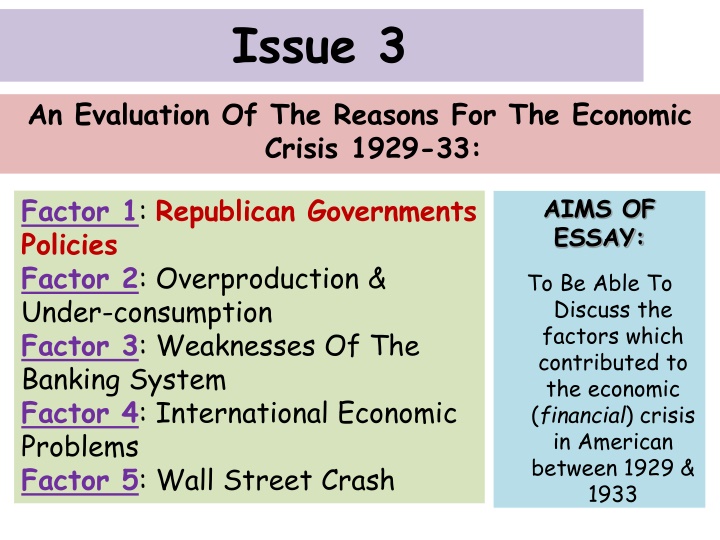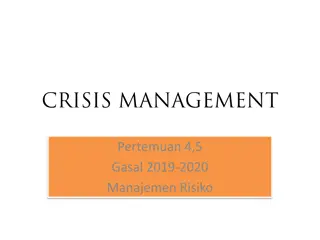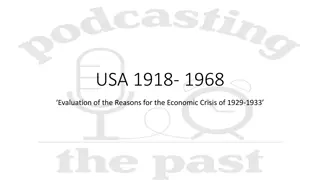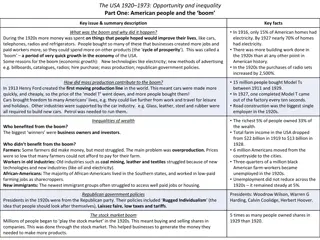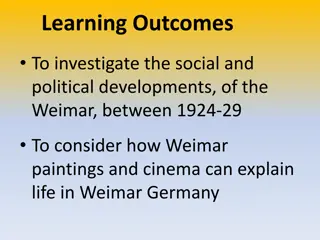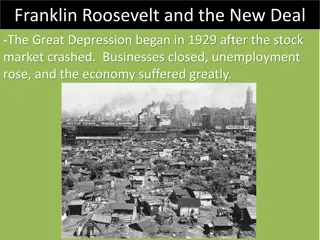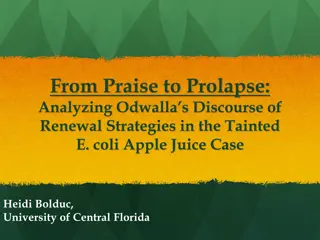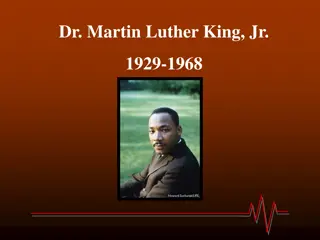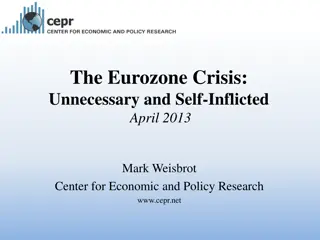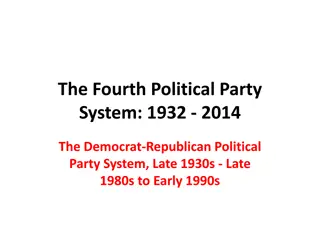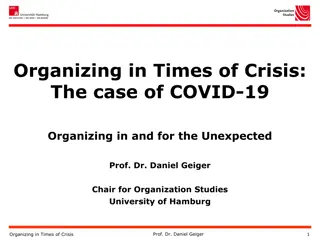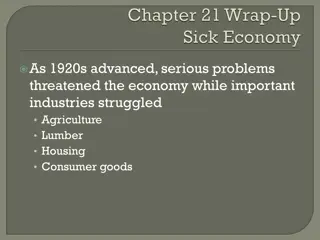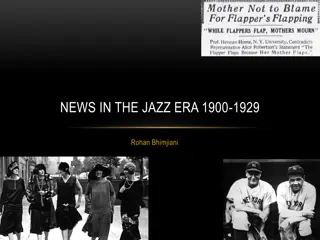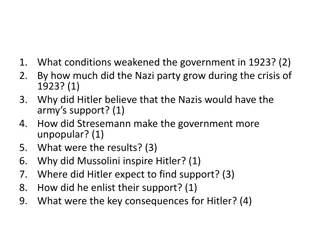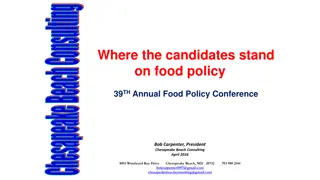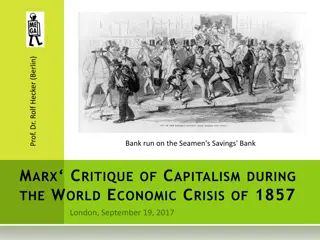Economic Crisis Factors 1929-33: Republican Policies & Overproduction
the factors contributing to the 1929-33 economic crisis, including Republican policies, overproduction, under-consumption, banking weaknesses, and international issues. Discover how laissez faire and tax reductions led to a flawed economic system that collapsed.
Download Presentation

Please find below an Image/Link to download the presentation.
The content on the website is provided AS IS for your information and personal use only. It may not be sold, licensed, or shared on other websites without obtaining consent from the author.If you encounter any issues during the download, it is possible that the publisher has removed the file from their server.
You are allowed to download the files provided on this website for personal or commercial use, subject to the condition that they are used lawfully. All files are the property of their respective owners.
The content on the website is provided AS IS for your information and personal use only. It may not be sold, licensed, or shared on other websites without obtaining consent from the author.
E N D
Presentation Transcript
Issue 3 An Evaluation Of The Reasons For The Economic Crisis 1929-33: Factor 1: Republican Governments Policies Factor 2: Overproduction & Under-consumption Factor 3: Weaknesses Of The Banking System Factor 4: International Economic Problems Factor 5: Wall Street Crash AIMS OF ESSAY: To Be Able To Discuss the factors which contributed to the economic (financial) crisis in American between 1929 & 1933
Aims Paragraph 1: To Understand The 3 Key Republican Economic Policies Of The 1920s To Understand The Consequences These Could To Have Have The Background Knowledge & Argument To Write Your First Paragraph For Essay 3 on the factors which contributed to the economic crisis
PLAN FOR PARAGRAPH 1 Republican Policies 1. Start with an Opening Argument e.g. state there is a link between the isolated factor & the question Read Through Paragraph 1 On Handout 2. Put in Knowledge Discuss Republican Policy 1: What does laissez faire mean? 3. Put in Analysis Explain what did this lack of regulation lead to? 4. Knowledge Discuss Republican policy 2: What did tax reduction lead rich people into doing more 5. Analysis Explain what was meant to happen but didn t & the effect it had 6. Evaluation Make an evaluation, sum up that it created a flawed system which would eventually fall down
WHO WERE THE REPUBLICANS? Republican Presidents Were In Office From 1921 To 1933. 1. Warren G Harding (1921-1923) Calvin Coolidge (1923-1929) Herbert Hoover (1929-1933) 2. 3.
What Were Their Economic Policies? FIRSTLY: They followed a policy of laissez faire which meant that the government interfered as little as possible in the running of the economy The term economy means: the state of a country in terms of the production and consumption of goods/services and the supply of money Laissez faire meant businesses were essentially unregulated & left alone Business men were left to create jobs and decide on wages (great for the poor) Being unregulated resulted in many businesses investing in the stock market The stock market & banks at the time was also under-regulated resulting to loans being taken out to be spent on stocks 1. LAISSEZ FAIRE The Problem Being If The Stock Prices Fall How Will They Ever Pay Back The Bank??
What Were Their Economic Policies? SECONDLY: Keep taxes as low as possible Resulting in a cut in government spending from $6.4 billion to $2.9 billion in just 7 years (e.g. schools) This had the dual purpose of (1) allowing businesses to invest more money to expand their operations (2) Giving consumers more money in their pockets to keep spending The government believed that money would trickle down through all levels of society and raise standards of American life 2. LOW TAXES however this didn t work during the 1920 60% were living on less than $2,000 a year while the top 5% owned 1/3 of Americas income The rich got richer and the poor stayed poor this had 2 outcomes: (1) The poor could not buy the goods they were producing leading to under- consumption (2)The rich bought more shares in the unpredictable market
What Were Their Economic Policies? THIRDLY: The Fordney-McCumber Act 1922 created strict tariff barriers imposed on foreign imports e.g. goods from Europe It reduced the number of foreign goods being sold in America The idea behind this was to led to an increase in American own goods being bought at the expensive of foreign goods This is known as protectionism However this back fired and the Europeans did the same putting a high tariff on Americans goods! Therefore the US economy could not expand into foreign markets as rapidly as they could produce resulting in over-production/under- consumption 3. Strict Trade Tariffs
SUM UP: Factor Each of these 3 polices will be mentioned throughout your essay: Laissez Fair; Low Tax & Trade Tariffs Arguably the Republican policies were key facilitators to the economic situation, leading to: 1. Overproduction & Under-consumption of American Goods 2. The failure of the Banking System 3. Problems with International Trade 4. The Wall Street Crash WHY the lack of regulation (laissez Fair); tax reductions for the rich (Low Tax) & the desire for protectionism (Trade Tariffs)
Background Questions Q1. Who were the Republican Presidents between 1921-31 Q2. What were the 3 main Republican economic policies? Q3. What does Laissez Faire mean? Q4. What is the economy of a country? Q5. What did many business men do with their profit Q6. Not only were businesses unregulated which 2 other organisations were? Q7. What problem could arise here? Q8. How much was government spending cut by? Q9. What were the 2 aims of low taxation? Q10. This was meant to improve living conditions for everyone in America however it did not how did the rich & poor differ? Q11. The rich got richer & the poor got poorer what 2 outcomes did this have? Q12. What was the Fordney-McCumber Act of 1922? Q13. What impact was this meant to have on goods in America? Q14. How did this backfire? Q15. What did the Republican policies lead to?
PLAN FOR PARAGRAPH ! Republican Policies 1. Start with an Opening Argument e.g. state there is a link between the isolated factor & the question Read Through Paragraph 1 On Handout 2. Put in Knowledge Discuss Republican Policy 1: what does laissez faire mean? 3. Put in Analysis Explain what did this lack of regulation lead to? 4. Knowledge Discuss Republican policy 2: What did tax reduction lead rich people into doing more 5. Analysis Explain what was meant to happen but didn t & the effect it had 6. Evaluation make an evaluation, sum up that it created a flawed system which would eventually fall down
OPENING ARGUMENT It can be argued that the laissez-faire approach from the Republican government was the biggest contributor to the economic crisis.
Republican Policies KNOWLEDGE 1 ARGUMENT 1 Discuss the first policy: What is laissez faire and what did this approach lead to?: This led to risky investments in the stock market And the vulnerability of losing everything if the market was to crash Unregulated Practises Easy Credit
Republican Policies KNOWLEDGE 2 ARGUMENT 2 It can be argued this profit was meant to trickle down to the working classes Who could then buy the goods they were producing and support the economy BUT this is not what happened the poor stayed poor & could not afford goods Discuss the next policy: tax reductions Ensured the wealthy got richer &profits led to increased investments in the stock market However
EVALUATION EVALUATION: Overall, Republican policies of the 1920s created a sense of well being and large profits however long-term they created a flawed system that allowed banks and the stock market to get out of control
